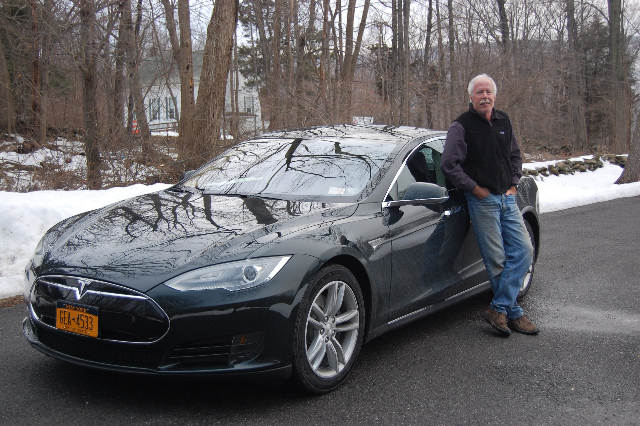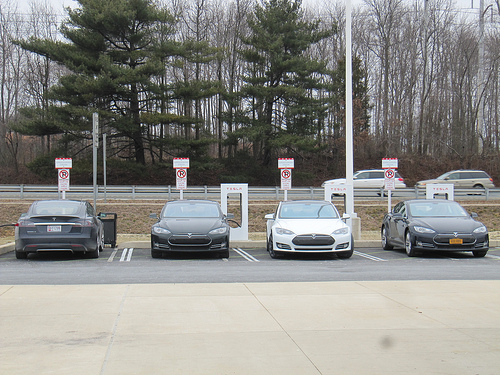
Tesla Supercharger fast-charging system for electric cars
As the brand-new owner of a 60-kWh Tesla Model S, I was eager to try out a Supercharger, the ultrafast 90-kilowatt DC fast-charging stations that Tesla is establishing along Interstate highways across the country.
Model S owners--and nobody else--will be able to plug in and grab up to 150 miles of extra range in 30 minutes, about the time it takes to empty their bladders and then eat a fast-food meal and/or check their mobile devices. Astonishingly, the Superchargers are free for Model S owners.
So far, Tesla Motors [NSDQ:TSLA] has installed five Superchargers in California and two along I-95 between Boston and Washington D.C.
Tesla claims it will have more than 100 Supercharger stations by 2015, enabling the Model S to make long cross-country trips just like a gasoline car.
For me, the nearest Supercharger is at the service area on I-95 in Milford, Connecticut, about 85 miles from my home in New York's Hudson Valley. Though my car's EPA range of 208 miles should manage the round trip without a recharge, I figured it would be fun to try out the Supercharger experience.
And it would be my first long trip in the car, a chance to check the accuracy of the "rated range" readout--also called the Guess-O-Meter--that so commands the attention of any electric-car driver.
Hopefully, my fate would be better than that of reporter John Broder of The New York Times, whose Model S famously ended up on a flatbed truck, out of juice, when he attempted a trip to the Milford Supercharger after leaving his Model S unplugged on a very cold night.
Unlike Broder, I started with a full charge. He had unwittingly charged the car in "Standard" mode, which--in the name of long-term battery health--stops charging at 90 percent of battery capaacity.
For my trip, just to be sure, I set the charger on "Max Range", which takes the charge to the full 100 percent. As I pulled out of my driveway on a cool 40-degree morning, the "rated range" read 198 miles.

2013 Tesla Model S electric sport sedan on delivery day, with owner David Noland
Still new to the car, I drove conservatively, cruising at 60-65 mph on open stretches and accelerating gently on more congested two-lane roads. Under those conditions, the Tesla's "Guess-O-Meter" was spot on. After about two hours, I pulled into the northbound side of the Milford service area showing 116 miles of range remaining--82 miles less than what I started with.
So far, so good. But where the heck was the Supercharger?
The picture on the Tesla website shows what looks like a four-bay carport, conspicuously Tesla-logoed, and flanked by a 15-foot-high sculpted phallic column of no obvious purpose. (A nod to the SpaceX Falcon 9, perhaps?)
But I could see nothing like that anywhere around.
Eyes swiveling, I drove slowly past the parking area, past the gas pumps, past the restaurant pavilion, finally to the truck ghetto at the far end of the service area.

Tesla Supercharger obelisk
No carport-cum-phallus.
And now, I realized, I was stuck. Traffic flow through the service area is one-way only. There was no going back.
I parked the car and backtracked on foot. After a few minutes of searching, I found the Supercharger station. No carport. No phallus. Just two adjacent spaces in the regular parking lot, each with a gas-pump-like charging station and a miniscule Tesla logo.
I can now understand why John Broder drove around in circles in the parking lot at Milford. Tesla CEO Elon Musk implied that he was trying to run down the battery on purpose; Broder said he just couldn't find the Supercharger. I can relate to that.
Luckily, both spaces were empty. But of course my car was now at the other end of the service area, marooned by "Do Not Enter" and "Wrong Way" signs.
If I wanted to charge up, my only legal recourse was to continue north on I-95, get off at the next exit, get back on I-95 southbound, drive to the next exit south, get off, get back on northbound, and return to the service area.
Fuhgeddaboudit.
I looked around for cops, saw none, and drove the wrong way back past the gas pumps to the Supercharger, encountering no other cars during my nefarious 20-second dash.

Tesla Road Trip from MD to CT, Feb 2013 - Tesla Model S cars at Delaware SuperCharger location
There were no instructions on the charger, just a phone number to call in case of problems. The charging plug was the same as the one I use at home.
Click the button on the plug, the charge door pops open. Plug in, and the glowing ring around the charge port turns blue, then green, and begins to pulse rapidly. Just like at home. Nothing to it.
Tesla brags that Superchargers are located at places "you'll actually want to stop." Not the Milford service area, a monument to low-rent fast food: McDonald's, Subway, Dunkin' Donuts. I used the bathroom (clean), grabbed a smoothie and a Danish, and was out of there in 26 minutes.
During that time, the car picked up 62 miles of range, bringing the Guess-O-Meter up to 178 miles, more than double the mileage home.
This fell far short of Tesla's claimed 150 miles in 30 minutes.
There are, however, two reasons.
First, I was more than half full when I plugged in. The charging rate is very fast for an empty battery, but it slows down as the battery fills up.
Second, I have the mid-size 60-kWh battery, not the big 85-kWh model. With less capacity, my charge rate presumably falls off more quickly. (A Tesla rep on the owners' hotline could shed no light on 60-kWh vs. 85-kWh charging rates for me.)
With my brain perhaps dulled by a fast-food sugar-and-fat buzz, I had some trouble getting the plug out. With no instructions, I did what I do at home to unplug: squeeze the button on the plug and pull.
But it wouldn't come out. With rising panic, I fiddled for 5 or 10 seconds, randomly pushing the button and tugging the cord. Nothing.
And then, thank God, it finally popped out, for no apparent reason.
(A Tesla hotline rep later confirmed that it takes longer for the Supercharger to shut down and release the charge cord. Might I suggest it would be nice to let Model S owners know that ahead of time?)
Fat with energy, I drove home at my normal 70 to 75 mph, and didn't stint on the acceleration. (Nothing crazy, though.) I arrived home with 76 miles remaining, for a net "usage" of 102 miles on the meter to cover the 88 miles home.
After trying out a Supercharger, I can see its potential. But Tesla needs to put the charging stations closer together.
The two Superchargers connecting Washington D.C., and Boston are about 200 miles apart. John Broder notwithstanding, that's probably okay for an 85-kWh car under most conditions. But it provides little margin for cold weather, fast driving, or Murphy's Law.

2012 Tesla Model S
And for 60-kWh cars like mine, it just doesn't work at all.
Okay, if I drive 55 mph and don't use the heat or air conditioning, I might make it by the skin of my teeth. Maybe. If nothing unexpected happens.
But I'm guessing this kind of razor's-edge driving is not what Tesla has in mind. It's certainly not what I have in mind; this weekend I'll be driving to Baltimore in my trusty Chevy Volt because I'm not willing to risk the 198-mile drive in the Model S from my house to the Supercharger in Newark, Delaware.
According to Broder, Elon Musk conceded that the Superchargers need to be 140 miles apart, not 200.
Speaking for all Supercharger-equipped 60-kWh Model S owners, I concur most heartily.
David Noland is a Tesla Model S owner and freelance writer who lives 60 miles north of New York City.
+++++++++++












